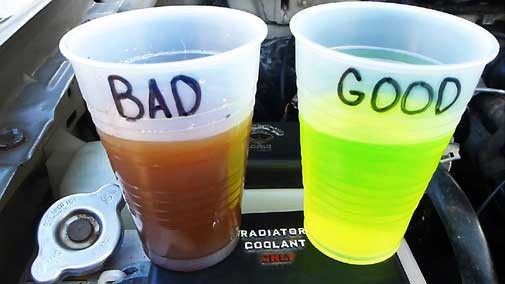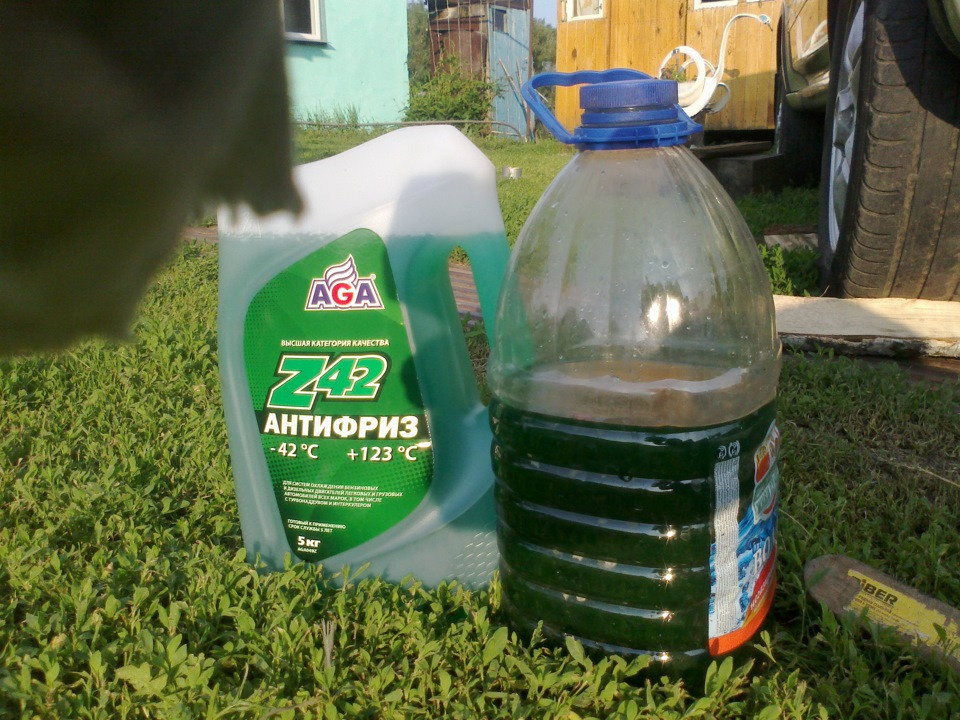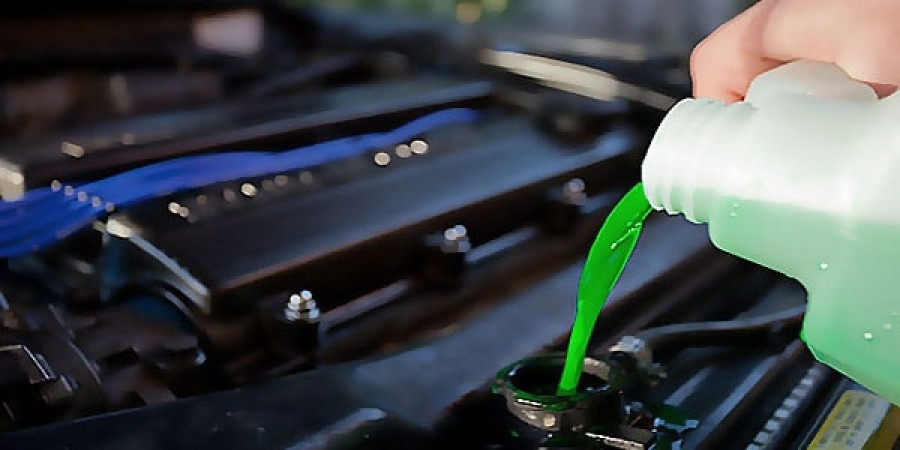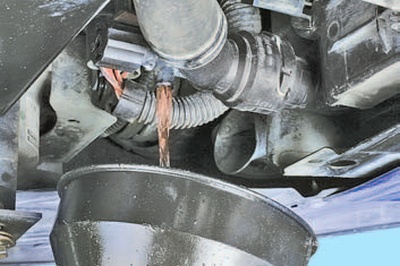
Honda CRV antifreeze replacement
Content

Antifreeze is a process fluid that does not freeze at low temperatures. The appointed liquid is intended for cooling of the working power unit of the car, namely Honda SRV, at an outside air temperature from +40C to -30,60C. In addition to its main function, antifreeze lubricates the internal surfaces of the Honda SRV cooling system, as well as the water pump. This feature helps prevent corrosion. The service life of the coolant depends on the condition of the coolant.
The purpose of the cooling system is to optimize vehicle performance. After all, the designated system is responsible for the normalization of the temperature regime of the propulsion system during its operation. Due to the critical importance of the cooling system to the correct operation of the vehicle, the vehicle owner must diagnose and service the vehicle. These actions must be carried out at a certain time, which is prescribed in the operating instructions for the machine. In order for the presented system to work properly, a Honda SRV brand motorist must regularly check the condition of the antifreeze and, if necessary, replace it.
The procedure for replacing the coolant in a Honda SRV car is not complicated. Based on this, the owner of the vehicle can cope with the presented task on their own, without resorting to the help of specialists. However, it should be noted that in this case, a certain procedure must be followed, which will be presented below. First you need to drain the coolant, flush the cooling system and finally fill in fresh antifreeze. Also in the content of the current article, information will be provided on how to choose the necessary antifreeze.
How to replace antifreeze on a Honda SRV?
It is necessary to systematically monitor the level of coolant in the expansion tank of the car. Due to the fact that the coolant is in a transparent container, it is easy to tell what level the antifreeze is at right now. In the normal state, the coolant should be at the pointer between the minimum and maximum designations. If the antifreeze is heated, then the coolant level should correspond to the maximum indicator, and in the reverse situation - to the minimum.
The owner of a Honda SRV car must add coolant according to the frequency set by the manufacturer, which is 40 thousand kilometers. It should also be noted that it is possible to replace the coolant every two years if the car owner rarely uses it. At the same time, it is required to regularly check the level of antifreeze and replace it when a brownish tint or darkening appears. In addition, the coolant must be replaced if its composition does not meet the required density, or engine repair, elements of the Honda SRV cooling system are necessary.
The required amount of refrigerant to be charged should be 10 liters. To use a Honda SRV car, it is recommended to fill in antifreeze, which is indicated in the instructions.
Keep in mind that there are certain circumstances that can help a Honda SRV owner determine the need for an antifreeze replacement.
Replacing the coolant on a Honda SRV car is required in the following cases:
- The stove of the Honda SRV car stopped working well. In a situation where the car's stove began to fail, it is recommended that the motorist check the condition of the antifreeze and, if necessary, replace it;
- If a foam emulsion has formed in the expansion tank in which the antifreeze is located. The corresponding container is located in the engine compartment of the Honda SRV. If the coolant loses its properties necessary for its optimal functioning, a chemical reaction occurs, as a result of which foam accumulates in the system;
- The power unit of a Honda SRV car periodically heats up. In a situation where antifreeze loses the properties it needs for optimal performance, the car engine begins to overheat. If the car owner noticed this, then it is imperative to check the condition of the antifreeze and, if necessary, replace it;
- If a precipitate has formed in the expansion tank, which is located in the engine compartment of a Honda SRV car. The result of the loss of physical properties of antifreeze is a chemical reaction, after which a precipitate forms in the coolant reservoir.
In addition to the above information, it should be clarified that if the owner of the vehicle repairs the heater, radiator or cylinder head, the reuse of antifreeze is prohibited.
In order to independently carry out the procedure for replacing antifreeze in a Chevrolet Niva car, its owner will need an inspection hole, overpass or lift. The car must be in a horizontal position and also well secured. The action shown is a precaution to keep the machine from moving during operation. The front of the Honda SRV should be mounted slightly higher than the rear. It should also be noted that this procedure is carried out only on a cold engine. Also, for self-replacement of antifreeze, the owner of the vehicle must prepare certain tools.
Tools needed to change the coolant in a Honda SRV car:
- Ratchet wrench;
- Extension of a certain length;
- Head of the following sizes 8, 10, 13 mm;
- Wrench;
- Pliers with narrow jaws;
- Knife;
- Watering can.
In addition to tools, the motorist will also need the following parts and supplies:
- Antifreeze 8 liters (with a margin of 10 liters);
- Technical capabilities;
- Sealing ring of a cover of a radiator (if necessary);
- Waste fabric;
- Plastic bottle.
The first stage
Before proceeding with the replacement of antifreeze, it must first be drained from the cylinder block. To do this, the motorist must adhere to a certain algorithm, which will be presented below.
The procedure for draining coolant in a Honda SRV car:
- First you have to drive the Honada SRV into the garage pit or use the overpass. It should be noted that the process of replacing antifreeze without fail is carried out with a cold power unit of the car;
 Good and bad antifreeze
Good and bad antifreeze
- Next, you need to find a reservoir to fill the coolant, and then remove the reservoir cap. In the event that the power unit heats up, hot steam should come out of the tank after unscrewing it. Based on the above information, when performing these actions, it is recommended to cover the cover with a rag;
- The next step is to crawl under the bottom of a Honda SRV car. If the power motor is with special protection, then it must be dismantled. To do this, unscrew the bolts fixing it;
- After draining the antifreeze from the pump into the replacement container below. If the car, i.e. Honda SRV, is equipped with power steering, then to perform the above task, it is necessary to dismantle the drive belt from the shaft of the pumping mechanism. After that, you need to unscrew the screws that hold the pump mount. In turn, the device must be turned on. The assigned action will allow you to access your pipes and lines that are connected to the thermostat;
- The pump is the lowest component of the Honda SRV cooling system and has three pipes connected to it. Since the middle line is too short, it is not recommended to touch it. The specified action is performed due to the fact that it is difficult to separate it without damaging it. Instead, you need to loosen the bolts on the clamps and remove them from the top line. This action will close the pipe and drain the antifreeze. Next, you need to loosen the clamp and unscrew the lower line, which is connected to the machine's cooling radiator. After performing the above steps, the old coolant is drained. To drain more antifreeze, you need to disassemble the thermostat flange and the device itself;
- However, the above steps will not completely drain the coolant. This is due to the fact that part of the antifreeze remains in the radiator device. To get rid of fluid residue, the motorist must disconnect the lower radiator hose and install a hose of the appropriate size in its place. After installing the hose, blow out the other end. The presented action allows you to remove the remaining antifreeze from the radiator unit, as well as from the center line of the pump, which has not been disconnected.
The second stage
After the owner of the Honda SRV has drained the spent antifreeze, he must thoroughly flush the car's cooling system. The presented action is performed according to a certain process and due to the fact that dirt and rust form in the channels of the system.
The procedure for flushing the cooling system of a Honda SRV car using a special flushing fluid:
- First you need to fill the car's cooling system with washer fluid. This action is carried out in the same way as when replacing used antifreeze with a new one;
- Next, you need to let the power unit of the car work from twenty to sixty minutes; the life of the car engine depends on how contaminated the drained coolant was. The dirtier the antifreeze, the longer the flushing of the cooling system;
- After the required period of time has elapsed, the owner of the Honda SRV must turn off the power unit. After that, the washing liquid is drained. Next, the cooling system is washed with distilled water;
- The above actions are necessary until the drained liquid is clean;
- After the owner of a Honda SRV car is convinced that the cooling system is clean, new antifreeze should be added.
In addition to the cooling system, the motorist should also flush the radiator on the Honda SRV.
The radiator of the presented car is washed as follows:
- To begin with, the owner of a Honda SRV car needs to disconnect all hoses from the car's radiator;
- In the next step, insert the hose into the inlet of the upper tank of the radiator, then turn on the water and rinse it well. It is necessary to continue to perform the indicated action until clean water comes out of the lower tank of the radiator;
- If running water does not help flush the Honda SRV radiator, a detergent is recommended;
- After flushing the car radiator, the car owner must flush the power unit.
The Honda SRV car engine is washed as follows:
- First you need to remove the thermostat, then temporarily install the thermostat cover;
- At the next stage, the owner of a Honda SRV brand car must disconnect the radiator hoses from the car, and then apply a stream of clean water to the cylinder block of the power unit. The presented action is carried out through the upper radiator pipe. It must be flushed until clean water comes out of the lower hose going to the radiator;
- Finally, you need to connect the cooling system hoses to the car and install the thermostat.
The third stage
Filling a new coolant into the Honda SRV car system is done as follows:
- If the owner of a Honda SRV car uses concentrated coolant, it must be diluted with distillate before being filled into the expansion tank. These liquids must be mixed in the proportions indicated on the container labels. In most cases, this is one to one, but it should be noted that there must be at least forty percent of antifreeze in the cooling system. Before pouring the finished mixture, it is required to check that all pipes, as well as lines, are not damaged. You also need to make sure that all clamps are tightened;

Preparation of the mixture
- The finished mixture of distillate with antifreeze must be poured into the neck of the expansion tank. Add this mixture carefully, slowly. This is necessary so that air pockets do not form in the Honda SRV cooling system. The coolant is filled almost to the maximum level;

Refueling with antifreeze
- The next step is to make sure the places where the thermostat connects to the radiator or coolant pump and pump are sealed. You can detect a leak when a white coating appears on the elements of the cooling system;
- After that, it is necessary to tightly tighten the tank cap located in the engine compartment. Next, you need to turn on the power unit of the Honda SRV car and let it run for a certain time (10 minutes). Must work at high speeds;
- After the vehicle's power unit has warmed up, the power unit's temperature controller should signal the ventilated device to turn on. Next, you can turn off the engine of the Honda SRV car. After completing the steps presented, the motorist must check the level of antifreeze in the expansion tank. When the engine warms up, the coolant level should be below the maximum value, but above the average;
- Next, you need to turn on the power unit of the Honda SRV car again. However, in this case, you should work at medium speeds. This action will remove air from the radiator, if any;
- At the final stage, it is necessary to turn off the engine of the machine, and then wait for it to reach the optimum temperature. After the power unit has cooled down, the motorist should check the level of antifreeze. Your level must be above the minimum value. If all the above steps are done correctly, then the temperature controller will display 80-90 degrees Celsius.
How to choose the right antifreeze for Honda SRV?
The cooling system of a Honda SRV car consists of several main elements and connecting pipes. Antifreeze is not poured into this system in its pure form, but is mixed in special proportions with distilled water. With an increase in the temperature of the internal combustion engine, the level of the coolant rises, since it is in the system under consideration under a certain pressure. Obviously, the cause of antifreeze leakage is defects in some of the components associated with sealing. Breakdowns can occur both with nozzles and with the elements themselves. It is important to note that in certain situations
Also, the cause of antifreeze leakage can be the natural wear of the cooling system elements, assembly errors during repairs in the engine compartment, mechanical damage, as well as serious violations of the rules for operating the Honda SRV, which led to the fact that the cooling system of the system is broken or depressurized.
In this case, you need to add the missing ingredient of this mixture. If the level of antifreeze in the expansion tank of a Honda SRV car drops sharply, then the vehicle owner needs to diagnose the cooling system.
After the owner of a Honda SRV brand car determines that the antifreeze needs to be replaced, he must decide on the choice of coolant.

Getting ready to replace antifreeze in a Honda SRV car
The refrigerants on the market today can be divided into the following four types:
- Hybrid
- Traditional;
- Lobrid;
- Carboxylate.
Most of the presented antifreezes are made on the basis of a mixture of water and ethylene glycol. Brands and types of coolants differ only in additives: anti-foam, anti-corrosion and others.
Traditional coolant contains additives based on the following substances: borates, phosphates, silicates, nitrites and amines. The above landings are present in the antifreeze presented at the same time. To protect the cooling system from corrosion, these coolants cover it with a special silicate film, which grows over time. If antifreeze is heated to 105 degrees, additives may precipitate. Specialized coolants are often sold under the name "Tosol", however, it should be noted that they differ from antifreezes produced during the Soviet Union. The antifreeze in question is the cheapest of all, but it is more expensive to use than others. This is due to the short shelf life. Often Tosol turns yellow after six months.
Hybrid coolants, like traditional antifreezes, contain inorganic additives, but some have been replaced by other carboxylic acid based additives. If a special inscription is indicated on the packaging of the old coolant, meaning that this antifreeze does not contain borates and silicates, then there are nitrates, amines and phosphates. The maximum period of use of the presented coolant is two years. You can fill in the specified antifreeze in any car, including the Honda SRV. However, it should be noted that it must not be mixed with a coolant based on carboxylic acids. But you can fill in after Antifreeze.
Antifreezes with additives based on carboxylic acids are designated as follows: G12 or G12 +. You can fill in the specified coolant in any car, including the Honda SRV car. The maximum period of use of the presented coolant is three years. A feature of the antifreeze under consideration is that a protective anticorrosive agent is formed only where there is a center of corrosion, and its thickness is very small. It should be noted that it is possible to mix G12 + with G11 antifreeze, but in this case the service life will inevitably be reduced.
Do not mix G12 with antifreeze. If the specified antifreeze is poured into the expansion tank of a Honda SRV car, rinsed with running water after antifreeze, it will inevitably begin to become cloudy. In this case, a finely dispersed mixture of washed silicate film particles is formed. The correct solution in the situation presented by the owner of a Honda SRV is to remove the film with an acid wash, after which it should be washed with water, and finally filled with fresh liquid.
Lobrid G12 ++ antifreeze is less common than the antifreezes presented above. In addition, it is the most expensive. The main advantage of this coolant is its long service life. You can mix this antifreeze with other brands, but in the case presented, it should be noted that its service life is reduced. Based on this, we can conclude that pouring lobrid antifreeze into the expansion tank of a moving car is not practical.

